Africa, Business Maverick, Media, Politics
A Decade In Pictures: 2003
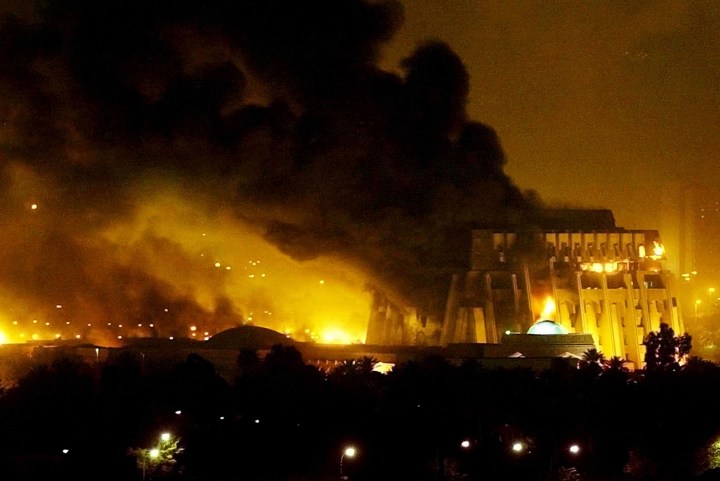
It was a year of war: The war dance was short and the US attack on Iraq was swift and precise. Saddam Hussein's Iraq was no match for the American war machine. But once they broke Iraq, Bush, Rumsfeld and others didn't really know what to do with it. By BRANKO BRKIC.
IRAQ WAR
5 February: US secretary of state Colin Powell makes a disastrous presentation to the UN Security Council on Iraq’s supposed programme around WMD (weapons of mass destruction), fails to convince just about anyone.

Photo: US secretary of state Colin Powell (R) talks with CIA director George Tenet (L) after his presentation to the UN Security Council in New York 5 February 2003. Powell tried to persuade a sceptical world that Iraq was concealing its weapons of mass destruction and that war may be necessary to disarm it. REUTERS/Mike Segar
19 March: Iraq War begins.
Watch: President Bush addresses the nation, announces operations have started. (Warning: Cringe-worthy)
Main photo for this story: An explosion rocks Baghdad during air strikes on 21 March 2003. US-led forces unleash a devastating blitz on Baghdad, triggering giant fireballs and deafening explosions and sending huge mushroom clouds above the city centre. REUTERS/Goran Tomasevic
1 May: In his speech on board aircraft carrier USS Abraham Lincoln, George W Bush announces the Iraq War is over, more or less. Behind him flies a banner proclaiming “Mission Accomplished”.
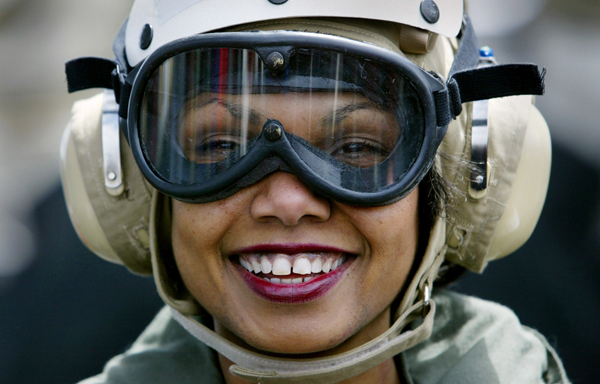
Photo: US national security advisor Condoleezza Rice can’t contain her excitement as she waits for George Bush to land on the USS Abraham Lincoln. REUTERS/Kevin Lamarque
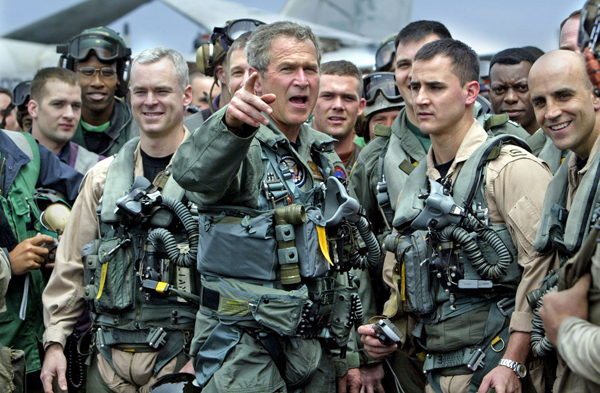
Photo: Bush meets with crew members on the deck of the USS Abraham Lincoln, after landing aboard an S-3B Viking. From the deck of the carrier, Bush addresses the US people to say that all major combat in Iraq has ended. REUTERS/Kevin Lamarque.
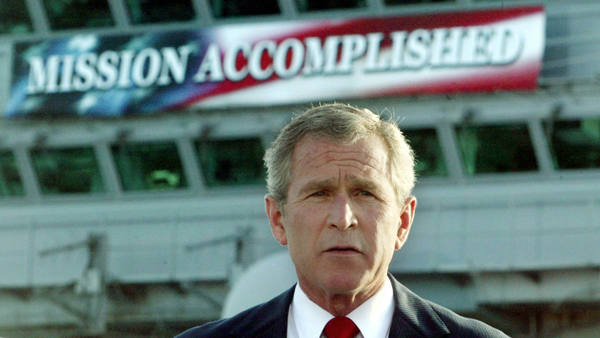
Photo: The White House admitted on 29 October 2003 it had helped with the production of a “Mission Accomplished” banner as a backdrop for President Bush’s speech. REUTERS/Larry Downing
22 July: Saddam Hussein’s sons, Uday and Qusay, are killed by US military in Mosul, who receive a tip-off from a local informant.
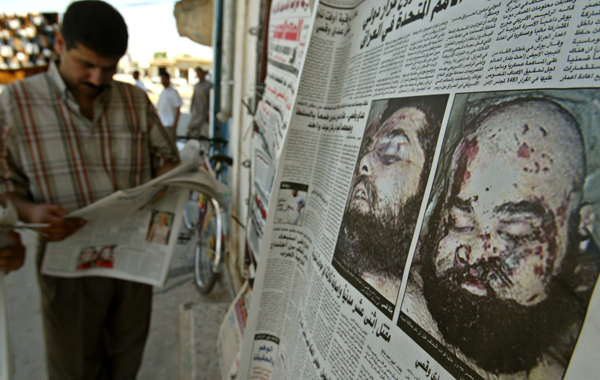
Photo: A man reads an Iraqi newspaper in the northern town of Tikrit after morgue photos of Saddam Hussein’s sons Uday and Qusay are published for the first time on 26 July. Hoping to convince Iraqis the two men were dead, the US military releases photos of the pair and allows a small group of media to view the bodies. REUTERS/Faleh Kheiber.
13 December: Saddam Hussein, the defeated dictator of Iraq, is captured in Tikrit by the US Infantry.
Watch: “Saddam Hussein’s last stand” by 60 Minutes. Well worth watching.
1 February: Space Shuttle Columbia joins Challenger on the grim list of space exploration catastrophes. The craft is doomed when, during take-off, a large piece of an external fuel tank’s insulation foam damages its left wing’s thermal protection layer. The weakened point is the first to give up under the huge pressure and temperatures during re-entry into Earth’s atmosphere. Predictably, all seven crew members are lost in the disaster.

Photo: The crew of Columbia pose for a group photo during their mission in January 2003. Bottom row, from left: William McCool, Rick Husband and Laurel Clark. Top from left: Michael Anderson, David Brown, Ilan Ramon and Kalpana Chawla. This image is recovered during search efforts and released on 24 June 2003.
9 February: War in Darfur starts. After years of what they saw as victimisation of non-Arab Sudanese in Darfur, the Sudan Liberation Movement/Army (SLM/A) and Justice and Equality Movement (JEM) groups in Darfur finally resort to arms. Sudanese authorities respond with armed forces and even more feared Janjaweed militias.
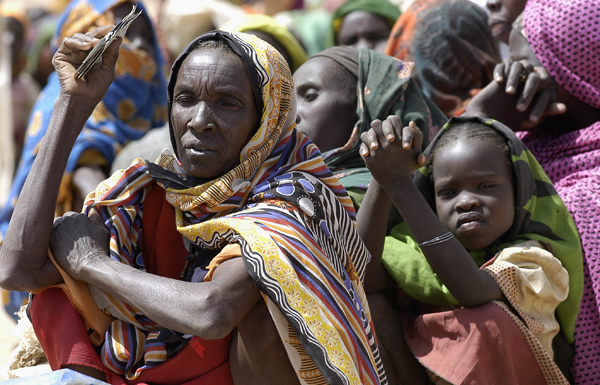
Photo: Seventy-year-old Arani Ardja Maniss waits in line for her family’s food ration in Iridimi camp under the scorching midday sun and stifling heat in the dry border area between Chad and Sudan. The UN says fighting between Janjaweed militias and African rebels in Darfur, western Sudan, has killed some 30,000 people in the first 12 months and created the world’s worst humanitarian crisis with 1 million people forced to flee their homes. REUTERS/OLAV A. SALTBONES
Severe acute respiratory syndrome (Sars) Crisis

Photo: An Italian patient of Vietnamese origin, suffering from the pneumonia-like Severe acute respiratory syndrome (Sars), breathes through a respirator in Hanoi’s National Institute for Clinical Research in Tropical Medicine, 3 April 2003. The patient is one of the eight Sars patients treated in Vietnam. The country’s total infections hit 63, including four deaths while more than 50 are discharged. REUTERS.
26 February: First patient admitted to French Vietnam Hospital.
12 March: World Health Organisation, alarmed by the nature of the disease, issues worldwide alert.
21 March: University of Hong Kong announces discovery of coronavirus as a possible cause of Sars.
12 April: Virus genome sequenced by British Columbia Cancer Agency in Vancouver.
5 July: WHO announces Sars is contained.
12 March: Serbian Prime Minister assassinated.
For all the reform-minded and European-looking Serbs, Zoran Djindjic is a hero, the man who ousted Slobodan Milosevic and sent him to The Hague to face his accusers. But to many other Serbs, including the organised crime groups, Djindjic is a traitor. After several attempts, a sniper finally ends Djindjic’s life, slowing down the pace of reforms. Once again, an assassination radically alters Balkan politics.

Photo: Hundreds of thousands of people walk in a silent procession towards Belgrade’s New Cemetery on 15 March 2003, where slain Serbian Prime Minister Zoran Djindjic will be laid to rest. Djindjic is assassinated on by a sniper. The funeral is the biggest in Belgrade since Yugoslavian President Josip Broz Tito died in 1980. REUTERS/Ivan Milutinovic.
15 March: Hu Jintao completes his ascent to power.
Although Jintao became Chinese communist party chief in 2002, his predecessor Jiang Zemin remained China’s President and did not really look forward to relinquishing his power. So the second major piece of power puzzle falls into the place when he becomes President, appointed by the National People’s Congress. (The third, and last piece of puzzle, chairmanship of Central Military Commission becomes his in 2004.)

Photo: China’s new President Hu Jintao listens to former president Jiang Zemin during a session of the National People’s Congress, or parliament, in Beijing on 17March 2003.
23 March: Australia wins 2003 Cricket World Championship.
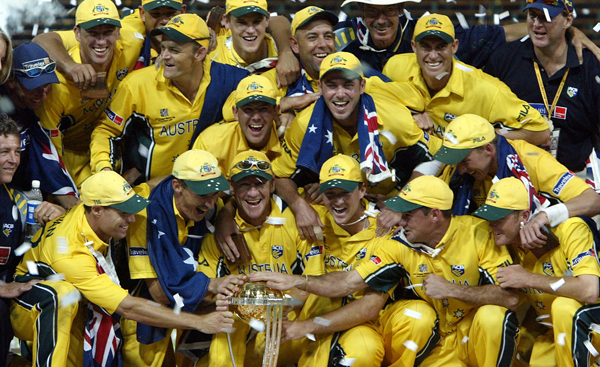
Photo: The Australian cricket team poses for photographers with the Cricket World Cup trophy after defeating India in the finals at the Wanderers in Johannesburg on 23March 2003. Australia, inspired by skipper Ricky Ponting’s majestic 140, retains the World Cup after outclassing India in Sunday’s final. The Indians, chasing an awesome 360 to win, are dismissed for 234 in the 40th over to lose by 125. Australia become the first side to win three World Cups. They are also the first side to retain the trophy since West Indies won the first two tournaments in 1975 and 1979. REUTERS/David Gray.
5 May: Walter Sisulu dies, aged 91.

Photo: Walter Sisulu, Nelson Mandela’s mentor since the 1940s and the “quiet engine” of South Africa’s struggle against white rule, dies on 5 May. REUTERS/Mike Hutchings
14 July: PlameGate starts as Robert Novak in his Washington Post column publishes the name of Valerie Plame, the former US ambassador in Iraq Joe Wilson’s wife, as a CIA agent, triggering a controversy that will last for years.

Photo: Valerie Plame, the woman at the centre of the CIA leak investigation, drives away from her home in Washington on 9 December 2005. Plame is expected to retire from the CIA after two decades. REUTERS/Mannie Garcia
11 August: Nato takes over in Afghanistan

Photo: German soldiers from the International Security Assistance Force form an honour guard during the change in command of the peackeeping operation for the Afghan capital from Germany and the Netherlands to Nato in Kabul on 11 August 2003. Command of the Kabul force is Nato’s first operation outside Europe in its 54-year history. REUTERS/Ahmad Masood.
25 August: The Spitzer Space Telescope is sent into space from Cape Canaveral.

Photo: A composite image of the Elephant’s Trunk Nebula, an elongated dark globule within the emission nebula IC 1396 in the constellation of Cepheus, one of the first images from the new Spitzer Space Telescope released by Nasa on 8 December 2003. The new Spitzer Space Telescope, that looks at the cosmos with infrared detectors, lifts the dust veils from newborn stars and a bumptious comet, and reveals the detail in the spiral arms of a neighbouring galaxy. Unlike the Hubble Space Telescope, which takes pictures of the universe from high in Earth orbit, Spitzer makes its observations as it trails behind Earth as our planet circles the sun.
12 September: Johnny Cash dies, four months after his wife, June Carter Cash, died. He was 71.
2 October: JM Coetzee wins Nobel Prize for Literature
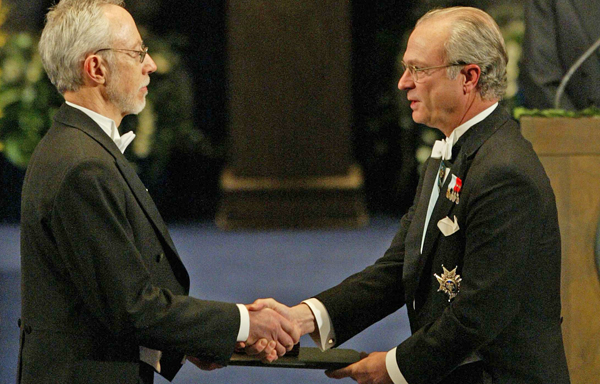
Photo: JM Coetzee receives the Nobel Prize for Literature from King Carl Gustaf of Sweden at the Concert Hall in Stockholm on 10 December 2003.
7 October: Arnold Schwarzenegger becomes Governator of California.
A long way from his roots in Graz, Austria, the star of “Terminator” ascends to the Californian gubernatorial throne freshly vacated by recalled previous governor, Gray Davis. On his way, he successfully manages to shake off allegations of drug use and mistreatment of women.
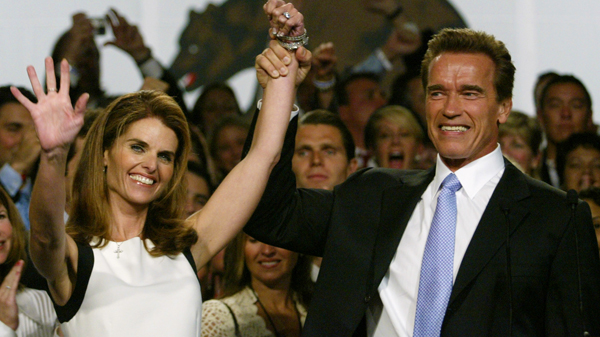
Photo: California gubernatorial candidate Arnold Schwarzenegger and wife Maria Shriver celebrate his win in the California recall election at the Century Plaza Hotel in Los Angeles on 7 October 2003. REUTERS/Robert Galbraith.
31 October: Mahatir Mohamad retires.
After 22 years, Malaysia’s longest-serving prime minister and, according to many, a strong-man, Mahatir finally bows out of politics. While he is credited with years of Malaysian growth, he also presided over the increasingly authoritarian regime that suppressed dissent and freedom of speech. In 1998 he famously sacked his own deputy, Anwar Ibrahim, after he raised his voice against the growing culture of corruption and ethnic Malay nepotism. Mahatir is succeeded by Abdulah Badawi, whom he later repeatedly criticises.

Photo: Former Malyasian prime minister Mahatir Mohamad attends an international conference in Tokyo on 3 June 2004. Mahatir is in Japan to attend a conference called “The Future of Asia”, along with other leaders from East Asian countries such as Vietnam, Thailand and Singapore. REUTERS/Yuriko Nakao.
22 November: England wins the 2003 Rugby World Cup after defeating Australia in Sydney.
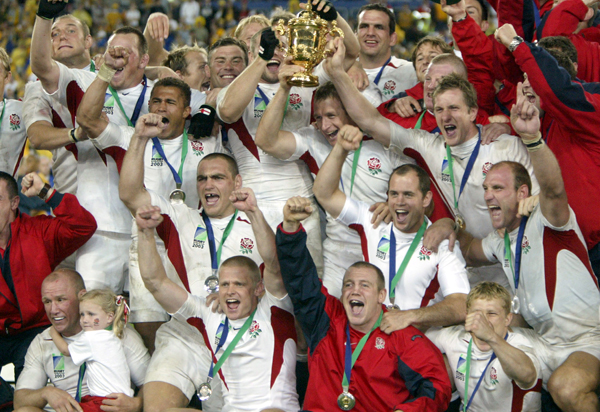
Photo: England players celebrate winning the Rugby World Cup final over Australia at the Olympic Stadium in Sydney on 22 November 2003. England wins the final 20-17. Reuters.
26 November: Concorde makes its last flight.
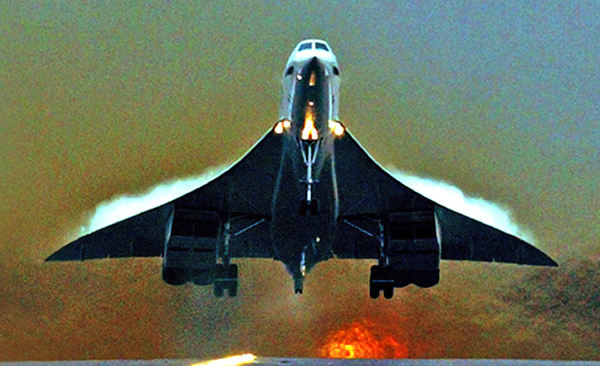
Photo: The final Concorde, Flight 216, takes off from London’s Heathrow Airport, en route to its birthplace Filton in western England, 26 November 2003. Concorde, which made more farewell tours than Frank Sinatra, let out its final supersonic roar as it hurtled across the Bay of Biscay at twice the speed of sound before starting its new earthbound life at a heritage centre in Filton. REUTERS/Lee Besford.
8 December: Rubén González, a brilliant pianist of Buena Vista Social Club fame, dies at 84.
20 December: Libya finally admits it’s been trying to build a nuclear bomb.
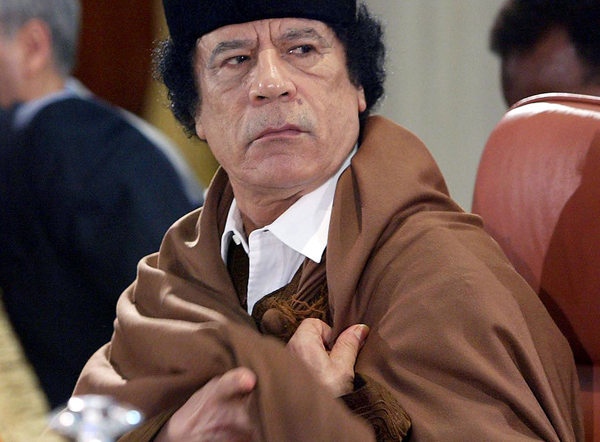
Photo: Libyan leader Col. Muammar Gaddafi participates in a working session held behind closed doors in Tunis during a summit of five southern European countries and five north African nations devoted to regional cooperation, December 6, 2003. REUTERS/Pool/ Patrick Kovarik.


















 Become an Insider
Become an Insider